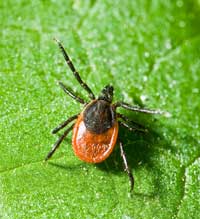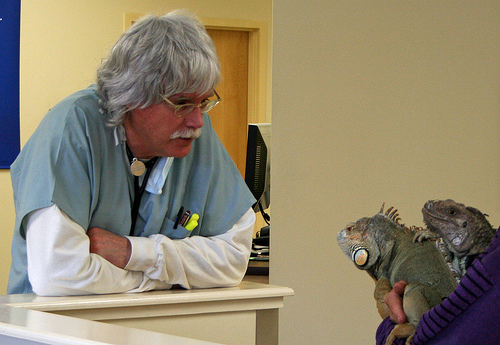
By Jennifer Kvamme, DVM
 Protecting your cat or dog (or both) from ticks is an important part of disease prevention. In fact, there are several diseases that can be transmitted to your pet from a tick bite. Some of the most common tick-borne diseases seen in the United States are Lyme disease, Rocky Mountain spotted fever, ehrlichiosis, and tick paralysis. Here we will briefly discuss these and some of the other tick-borne diseases that affect dogs and cats.
Protecting your cat or dog (or both) from ticks is an important part of disease prevention. In fact, there are several diseases that can be transmitted to your pet from a tick bite. Some of the most common tick-borne diseases seen in the United States are Lyme disease, Rocky Mountain spotted fever, ehrlichiosis, and tick paralysis. Here we will briefly discuss these and some of the other tick-borne diseases that affect dogs and cats.
Also called borreliosis, Lyme disease is caused by the bacteria Borrelia burgdorferi. Deer ticks carry these bacteria, transmitting them to the animal while sucking its blood. The tick must be attached to the dog (or cat) for about 48 hours in order to transmit the bacteria to the animal’s bloodstream. If the tick is removed before this, transmission will usually not occur.
Common signs of Lyme disease include lameness, fever, swollen lymph nodes and joints, and a reduced appetite. In severe cases, animals may develop kidney disease, heart conditions, or nervous system disorders. Animals do not develop the tell-tale "lyme disease rash" that is commonly seen in humans with Lyme disease.
Blood tests are necessary to diagnose Lyme disease in pets. If the results are positive, oral antibiotics are given as treatment for the condition. Dogs that have already had Lyme disease are able to get the disease again — they are not immunized against it — so prevention is key. A vaccine for Lyme disease is available for dogs, but unfortunately, the vaccine is not available for cats. If you live in an area where these ticks are endemic, you should have your dogs vaccinated yearly.
A disease seen commonly in dogs in the east, Midwest, and plains region of the U.S. is Rocky Mountain spotted fever (RMSF). Cats can be infected with RMSF, but the incidence is much lower for them. The organisms that cause RMSF are transmitted by the American dog tick and the Rocky Mountain spotted fever tick.
The tick must be attached to the dog or cat for at least five hours in order for transmission of the organism to occur. Signs of RMSF may include fever, reduced appetite, depression, pain in the joints, lameness, vomiting, and diarrhea. Some animals may develop heart abnormalities, pneumonia, kidney failure, liver damage, or even neurological signs (e.g., seizures, stumbling).
Blood tests can show antibodies to the organism, signifying that the animal has been infected. Oral antibiotics are used for about two weeks to treat the infection. Animals that are able to clear the organism will recover and remain immune to future infection. However, if your dog or cat has heart, liver, or kidney damage, and/or the nervous system has been affected by the infection, it may require additional supportive treatment, generally in hospital.
Currently, there is no vaccine available to prevent RMSF, so tick control is very important for animals living in endemic areas.
Another tick-borne disease that affects dogs is ehrlichiosis. It is transmitted by the brown dog tick and the Lone Star Tick. This disease is caused by a rickettsial organism and has been seen in every state in the U.S., as well as worldwide. Common symptoms include depression, reduced appetite (anorexia), fever, stiff and painful joints, and bruising. Signs typically appear less than a month after a tick bite and last for about four weeks.
Special blood tests may be needed to test for antibodies to Ehrlichia. Antibiotics are usually given for up to four weeks to completely clear the organism. After infection, the animal may develop antibodies to the organism, but will not be immune to reinfection. There is no vaccine available for ehrlichiosis. Low doses of antibiotics may be recommended for animals during tick season in areas of the country that are endemic to this disease.
Deer ticks and western black-legged ticks carry the bacteria that transmit canine anaplasmosis. Another form of anaplasmosis (caused by a different bacteria) is carried by the brown dog tick. Both dogs and cats are at risk for this condition. Because the deer tick also carries other diseases, some animals may be at risk for developing more than one tick-borne disease at a time.
Signs of anaplasmosis are similar to ehrlichiosis and include pain in the joints, fever, vomiting, diarrhea, and possible nervous system disorders. Pets will usually begin to show signs of disease within a couple weeks after infection. Diagnosis of anaplasmosis will usually require blood tests, urine tests, and sometimes other specialized lab tests.
Oral antibiotics are given for up to a month for treatment of anaplasmosis, depending on the severity of the infection. When treated promptly, most pets will recover completely. Immunity is not guaranteed after a bout of anaplasmosis, so pets may be reinfected if exposed again.
Tick paralysis is caused by a toxin secreted by ticks. The toxin affects the nervous system in mammals. Dogs affected become weak and limp, while cats don’t appear to have much trouble with the condition. Signs begin about a week after an animal is first bitten by ticks. It typically begins with a weakness in the rear legs, eventually involving all four limbs, followed by difficulty breathing and swallowing. Death may result if the condition progresses further.
If ticks are found on the animal, removing them should cause a rapid recovery. Depending on the severity of the condition, supportive treatment (e.g., breathing assistance) may be needed for survival. An antitoxin is available, which can be given if the condition is discovered quickly.
A disease that is transmitted by both ticks and fleas is haemobartonellosis. It is caused by an organism that targets red blood cells in the affected animal, leading to anemia and weakness. This condition affects both cats and dogs. In cats, the condition is also known as feline infectious anemia. In dogs, the disease is usually not apparent unless the animal already has underlying issues.
Diagnosis of haemobartonellosis is done by examining blood samples to look for the organism. Specialized lab tests are also available. Treatment with antibiotics must be given for several weeks, and transfusions may be necessary for some animals.
Also known as rabbit fever, tularemia is caused by a bacteria carried by four varieties of ticks in North America. Fleas may also carry and transmit tularemia to dogs and cats. Cats are usually more affected by this condition than dogs. Symptoms in dogs are reduced appetite, depression, and a mild fever. Cats will exhibit high fever, swollen lymph nodes, nasal discharge, and possibly abscesses at the site of the tick bite. Younger animals are usually at higher risk of contracting tularemia.
Blood tests are generally taken to look for antibodies to the bacteria that cause tularemia, signifying exposure and probable infection. Antibiotics are given to treat this condition in positively identified animals. There is no preventive vaccine for this condition, so keeping cats indoors and using flea and tick control measures are important. Restricting your pet from hunting rodents, rabbits, and animals that carry the disease will also help protect your pet from acquiring the disease.
Protozoa, those tiny single celled animal-like organisms, are the parties to blame when dogs and cats are diagnosed with babesiosis. Ticks transmit the protozoan organism to animals, where it sets itself up in the red blood cells, causing anemia. Babesiosis is usually seen in the southern U.S., but can also be found in the northeastern part of the country.
Signs of babesiosis in dogs are typically severe. They include pale gums, depression, dark-colored urine, fever, and swollen lymph nodes. In severe cases, the animal may collapse suddenly and go into shock. Blood and urine tests, as well as specialized diagnostic testing, will be used to look for signs of the organism in the affected animal.
Dogs that survive the disease will usually remain infected and future relapses may occur. There is no vaccine available for protection from babesiosis.
Cats are the species at risk for being infected with cytauxzoonosis. This parasitic disease is transmitted by ticks and is more commonly reported in the south central and southeast United States. Cats typically become very ill when infected, as the parasite affects many parts of the body.
Cats may develop anemia, depression, high fever, difficulty breathing, and jaundice (i.e., yellowing of the skin). Treatment is often unsuccessful, and death can occur in as short as one week following infection.
Immediate and aggressive treatment with specialized drugs, intravenous fluids and supportive care are typically necessary. Cats that recover from cytauxzoonosis may be carriers of the disease for life. There is no vaccine for this disease, so tick prevention is important.
Dogs in the south central and southeastern United States are at greater risk for contracting American canine hepatozoonosis (ACH). The Gulf Coast tick carries this particular disease. This tick-borne disease is brought on by the actual ingestion of a nymphal or adult stage tick, rather than by transmission through attachment and biting of the dog's skin by the tick. It is suspected that the ingestion takes place during self grooming, or when the dog eats an infected animal.
Infection is severe and often fatal. Symptoms include high fever, stiffness and pain upon movement, weight loss, and complete loss of appetite. The muscles will begin to waste away, an outward symptom that will become most apparent around the dog’s head. Discharge from the eyes is also very common.
Tests can be done to find the parasites in the dog’s blood, discharge, or muscle tissue. Treatment with anti-parasitic drugs, along with anti-inflammatories and antibiotics, is necessary for some time after diagnosis. If the dog recovers, follow-up medication for several years may be necessary, as a relapse of this disease is possible.
 How to Become a Veterinarian
By T. J. Dunn, Jr., DVM
Many are th
How to Become a Veterinarian
By T. J. Dunn, Jr., DVM
Many are th
 Pet Dentistry: Why Dogs (and Cats) Need Dental Care Too
By T. J. Dunn, Jr., DVM
Pet dentist
Pet Dentistry: Why Dogs (and Cats) Need Dental Care Too
By T. J. Dunn, Jr., DVM
Pet dentist
 Lyme Disease in Pets
Tick-Borne Diseases and Your Pet
By Jennifer Kvamm
Lyme Disease in Pets
Tick-Borne Diseases and Your Pet
By Jennifer Kvamm
 6 Exercises You Can Do With Your Dog
By Andrew Daniels
Man’s best friend m
6 Exercises You Can Do With Your Dog
By Andrew Daniels
Man’s best friend m
 Should I Give My Dog Supplements?
By Ashley Gallagher, DVM
Vitamins and supplements
Should I Give My Dog Supplements?
By Ashley Gallagher, DVM
Vitamins and supplements
Copyright © 2005-2016 Pet Information All Rights Reserved
Contact us: www162date@outlook.com